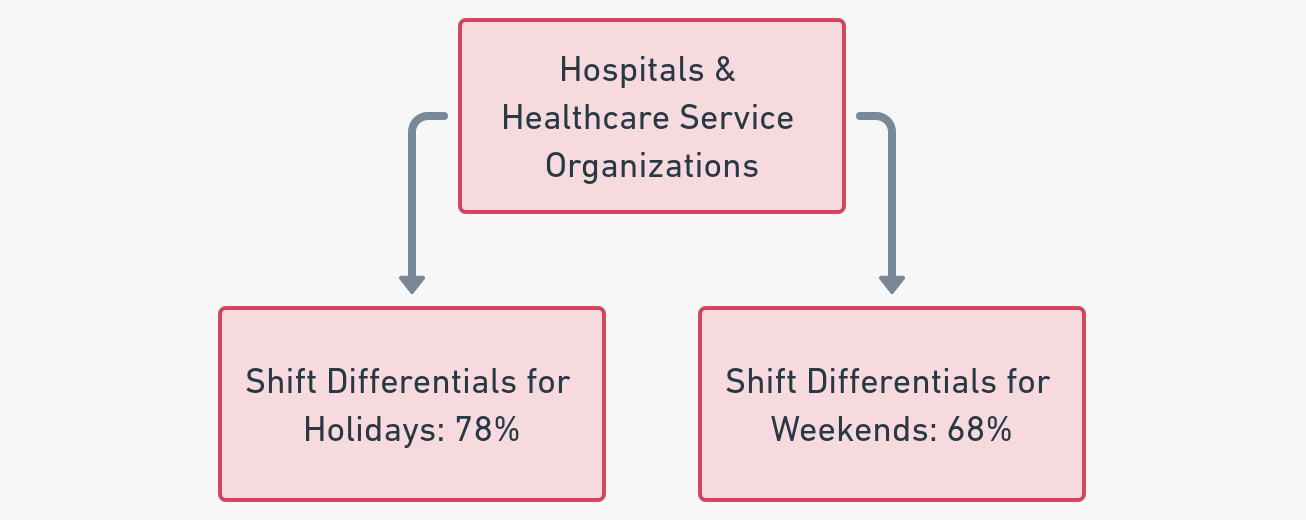30-seconds summary:
We’re here to talk about a crucial part of compensation that many employers offer: shift differential pay.
Offering shift differential pay is not just about providing extra money. It’s a reflection of an employer’s acknowledgment of the sacrifices and adjustments employees make to accommodate business needs. By compensating them fairly for these shifts, employers can:
- Attract Talent: Competitive pay rates, including shift differentials, can make a position more appealing to potential employees.
- Retain Employees: Recognizing the efforts of current employees can boost morale and reduce turnover.
- Ensure Operational Efficiency: Especially in industries that require 24/7 operations, shift differentials ensure that there are always motivated employees ready to work, regardless of the hour.
In essence, shift differential pay is a strategic tool that benefits both the employer and the employee, fostering a positive work environment and ensuring continuous business operations. Around 57% of companies offer shift differential pay as a way to incentivize candidates and workers.
What is Shift Differential Pay?
There are a lot of components involved in employee compensation, so it’s tricky to figure out what to do. It’s especially relevant for businesses that operate outside of standard hours. But what exactly is shift differential pay, and how does it compare to regular pay? Let’s take a closer look.
Shift differential pay is a simple concept: employees who work during less desirable or more challenging hours get more pay. Essentially, during specific hours the hourly rate if higher than the standard wage.
Why?
- Recognition: It acknowledges the inconvenience or challenges of working during unconventional hours.
- Incentive: It acts as a motivation for employees to willingly take up these shifts, ensuring that businesses can operate seamlessly around the clock.
- Fairness: It ensures that employees are compensated justly for the additional demands of working outside standard hours.
Difference Between Regular Pay and Shift Differential
An employee’s regular pay is the standard pay they get for their work during normal business hours. It’s agreed upon in their employment contract and it’s the same every day, no matter what time it is.
On the other hand, shift differentials are extra pay added to your regular salary. They’re either a percentage or a fixed amount. The employee who works the night shift might get 10%-15% (or ~$1) more as shift differential for working the night shift, making their total hourly wage $11 that day.
Differential pay can be applied in a lot of situations, including:
- Night Shifts: Because of the challenges of working overnight, employees often get shift differentials.
- Weekends: Employees working weekends might get extra pay if weekends aren’t part of the business’s standard operating days.
- Holidays: It’s common to get shift differential pay when you work on major holidays.
- On-Call Shifts: You might get a shift differential if you’re on standby and you get called in outside your regular hours.
- Hazardous Conditions: Depending on the industry, certain shifts might involve more challenging or hazardous conditions, so you’ll get paid more.
Factors Influencing Shift Differentials
A shift differential plays a key role in employee compensation, especially for businesses that operate outside of conventional working hours. It is not arbitrary to determine the rate or amount of shift differentials. Let’s examine some of the key factors that influence the amount an employee earns for working non-standard hours:
Time of the Shift
The specific hours an employee works can significantly impact the shift differential they receive. Common time-based factors include night shifts, weekends, and holidays.
Industry Standards and Practices
Different industries have varying norms when it comes to shift differentials. For instance, the healthcare industry operates 24/7, so shift differentials are common, especially for nurses or emergency room technicians requiring round-the-clock care.
A factory or manufacturing unit that runs continuously might offer shift differentials to ensure smooth operations.
In retail, employees may receive shift differentials during peak sales or shopping seasons. Businesses must keep up with industry standards so they remain competitive.
Employee Role and Responsibilities
The nature of an employee’s job and the responsibilities they shoulder can also influence shift differentials. Some roles might inherently demand working during unconventional hours or under challenging conditions.
For example employees guarding premises at night might get a higher differential than those on duty during the day.
If you’re providing technical support to global clients, you might need to work different shifts in different time zones.
Firefighters, paramedics, and other emergency responders might have irregular schedules, with shift differentials reflected in the unpredictable nature of their jobs.
| Factorial Insight: Hospitals and healthcare service organizations pay differentials more often than other types of organizations for holiday (78%) and weekend shifts (68%). |
Benefits of Offering Shift Differentials
The job market is becoming increasingly competitive. The provision of shift differentials is one such strategy, especially relevant to companies operating outside of traditional working hours. Shift differentials aren’t just a monetary benefit, they offer many other advantages as well. Let’s check some of the main ones.
Attracting and Retaining Talent
A competitive edge can be gained by offering attractive shift differentials in industries where shift work is common. Non-standard working hours are more likely to be compensated fairly by prospective employees.
Providing shift differentials reduces turnover rates, which results in decreased recruitment and training costs for employers.
Ensuring Continuous Operations, Especially in 24/7 Industries
Shift differentials ensure that industries that require round-the-clock operations, such as healthcare, hospitality, and emergency services, always have a motivated workforce.
Customers expect consistent service in a globalized world. Shift differentials ensure customer satisfaction and loyalty by providing consistent service.
Boosting Employee Morale and Satisfaction
Employees who work irregular hours are recognized and appreciated by employers who offer shift differentials.
Employees are more likely to be engaged and committed to their jobs when they feel that their efforts are acknowledged and rewarded during challenging shifts.
Shift Differentials in Practice
Prevalence in Various Industries
- Healthcare: Shift differentials are common in healthcare, since nurses, ER technicians, and other healthcare professionals often work night shifts, weekends, and holidays.
- Manufacturing: Many factories and production units operate continuously with multiple shifts, with differential pay ensuring smooth transitions and consistent productivity.
- Retail: Shift differentials might be warranted during peak shopping seasons, holiday sales, or inventory counts.
- Hospitality: Staff working during peak hours or overnight often receive shift differentials in hotels, restaurants, and other hospitality services. In the hospitality sector, effective restaurant shift management includes using a shift differential to compensate staff who work during peak hours or overnight.
- IT and Technical Support: Clients in different time zones may require IT professionals and customer support teams to work in shifts, with differential pay.
Common Rates and Calculations
- Percentage-Based: One of the most common methods is to offer a percentage of the employee’s base pay as shift differential. For example, a 10% differential on a $20 hourly wage would result in an additional $2 per hour.
- Flat Rate: Some companies might offer a fixed amount, regardless of the employee’s base pay. For instance, an extra $3 per hour for night shifts.
- Combination: In some cases, employers might use a combination of percentage and flat rate, ensuring that the differential is both fair and competitive.
- Variable Rates: The differential rate might vary based on the time or day of the shift. For example, weekend shifts might attract a higher differential than evening shifts on weekdays.
Shift Differential vs. Overtime
If your business operates outside of the standard nine-to-five schedule, shift differentials and overtime pay are crucial elements of employee compensation. There’s a lot in common between them, but they serve different purposes and are governed by different laws. Here’s what we’ll see about their differences, similarities, and legal nuances.
Key Differences in purpose:
| Shift Differential | Overtime |
| Providing employees with extra compensation for working nights, weekends, or holidays helps incentivize and compensate them fairly for the inconvenience. | Overtime pay is compensation for working beyond the standard work hours in a given period, typically more than 40 hours in a week. |
Key Differences in calculation:
| Shift Differential | Overtime |
| It can be a fixed amount or a percentage of the base pay added to the regular hourly wage for the specific hours worked outside standard hours. | It’s typically calculated as a percentage (often 150%, known as “time and a half”) of the employee’s regular hourly rate for each hour worked beyond the standard workweek. |
Key Differences in applicability:
| Shift Differential | Overtime |
| Applies to specific shifts or hours, regardless of the total hours worked in a week. | Applies when an employee exceeds the standard number of work hours in a week, regardless of the shift they work. |
Key Similarities:
| Additional Compensation | Incentive |
| Both serve as additional compensation over the regular hourly wage. | Both can act as incentives – shift differentials to encourage employees to work less desirable hours, and overtime to compensate for extended work hours. |
Legal Implications and Requirements
| Shift Differential | Overtime |
| Not Legally Mandated: In most jurisdictions, employers are not legally required to offer shift differentials. However, if they choose to do so, they must adhere to any agreements or contracts in place. | Legally Mandated: In many countries, including the U.S., employers are legally required to pay overtime to eligible employees who work beyond the standard work hours. The Fair Labor Standards Act (FLSA) in the U.S., for instance, mandates that non-exempt employees receive at least time and a half for hours worked beyond 40 in a week. |
| Inclusion in Overtime Calculations: In some regions, if an employee is receiving shift differentials and works overtime, the differential might be included in the base rate when calculating overtime pay. | Exemptions: Some employees, based on their job duties and salary, might be exempt from overtime requirements. It’s crucial for employers to be aware of these exemptions to avoid legal complications. |
Challenges in Implementing Shift Differentials
A shift differential can provide employees with incentives and fair compensation, but it can be challenging to implement. Shift differentials face a variety of obstacles, from technical difficulties in payroll configurations to employee concerns. These obstacles include:
Configuring Payroll Systems
- Complex Calculations: If an employee works multiple shifts with different rates within a pay period, payroll systems need to handle multiple differential rates.
- Integration with Time-Tracking: To apply the correct differential rates, payroll systems must seamlessly integrate with time-tracking tools.
- Regular Updates: Payroll systems need to be flexible so they can adjust shift differential rates as business needs change or industry standards change.
Ensuring Fairness and Consistency
- Standardized Policies: Businesses need to have clear and standardized policies in place to determine who is eligible for shift differentials and at what rates. This ensures that employees in similar roles and shifts receive consistent compensation.
- Transparency: It’s crucial for employers to communicate the rationale behind shift differential rates to their employees. This fosters trust and ensures that employees understand how their compensation is determined.
- Regular Reviews: To maintain fairness, businesses should periodically review their shift differential policies, taking into account industry benchmarks, employee feedback, and business needs.
Addressing Potential Employee Concerns
Perceived Inequities: Shift differentials may be perceived as unfair by employees if they do not adequately compensate for a particular shift’s challenges. Open communication and adjustments to rates are necessary to address such perceptions.
Work-Life Balance: Work-life balance may be a concern for employees who work non-standard hours. Providing solutions to these concerns, such as rotating shifts or non-monetary benefits, is crucial for employers.
Health and Safety: It is important to ensure safe working conditions, offer health benefits, and provide wellness programs to employees working unconventional hours.




